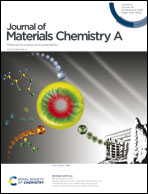Light-induced electrostatic lithography: selective discharge of electrets by utilizing photothermal conversion of Ti3C2Tx MXene†
Abstract
Charge/light-related advancements have greatly pushed the development of modern technology, and the relationship between charge and light is worth exploring. While research into the applications of light and charge flow (photoelectric current) is in full swing, studies on the reaction between light and electrostatic charge have made little progress on rare ways to realize photo-stimulated discharge. Herein, we link electrostatic charge and light using a bridge of intense heat, which is produced from the efficient photothermal conversion of Ti3C2Tx MXene. The in situ photothermal conversion and selective thermally stimulated discharge are successfully combined, then novel light-induced electrostatic lithography can be realized on both polymethyl methacrylate glasses and nanofilms. In this process the surface temperature of Ti3C2Tx film can be as high as 300 °C using 808 nm near-infrared irradiation at a power density of 1.7 W cm−2. The combination of light and electrostatic charge is also successfully applied to electrostatic printing and chemical reactions.



 Please wait while we load your content...
Please wait while we load your content...